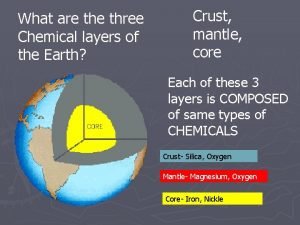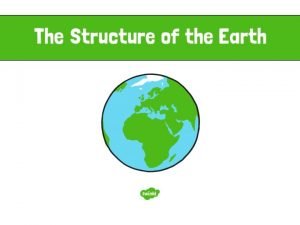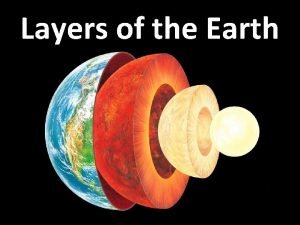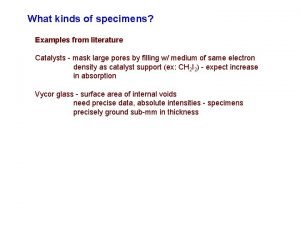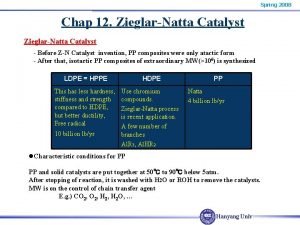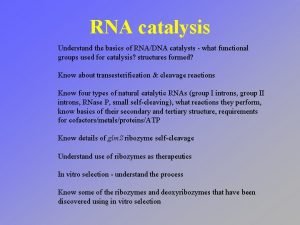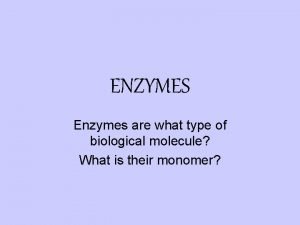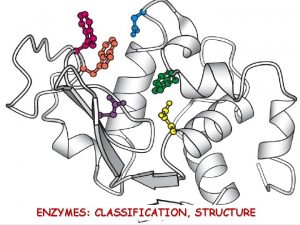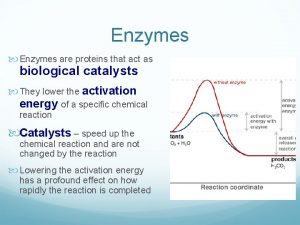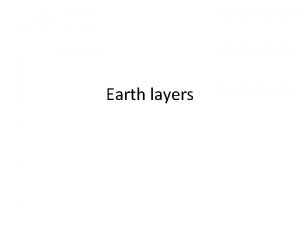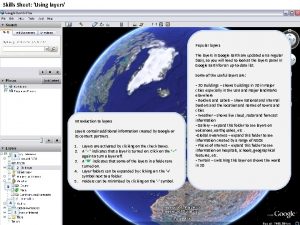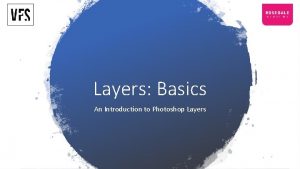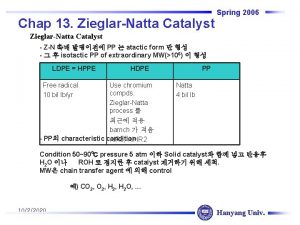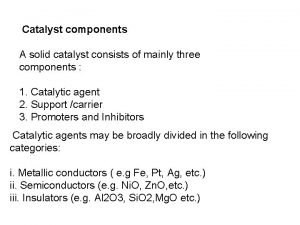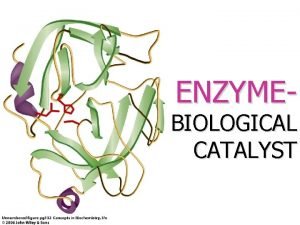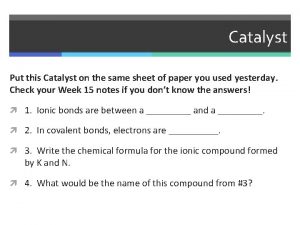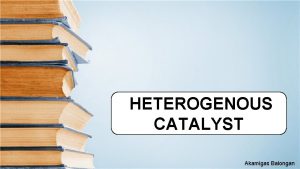Catalyst Questions What are the five layers of





















- Slides: 21

Catalyst Questions • • What are the five layers of the epidermis? List the functions of the skin. How does the skin respond to aging? What is the rule of nines?

Lets Review… • Resistance to trauma and infection, water retention, vitamin D synthesis, sensation, thermoregulation, and nonverbal communication. • Stratum basale, stratum spinsum, stran granulosum, stranum lucidum, and stratum corneum.

Epidermal Layers and Keratinization 5 -3

Effects of Aging on the Integumentary System • Skin more easily damaged because epidermis thins and amount of collagen decreases • Skin infections more likely • Wrinkling occurs due to decrease in elastic fibers • Skin becomes drier • Decrease in blood supply causes poor ability to regulate body temperature • Functioning melanocytes decrease or increase; age spots • Sunlight ages skin more rapidly 5 -4

The Rule of Nines • Used to estimate amount of body that is burned. • Note differing proportions in adult and child. 5 -5

Class Updates… • Review day on Wednesday August 24 th, plus in class project! • Test corrections on due on Monday, September 22 nd. • Test will be on Friday, 26 th !

Review Sheets • A completed review sheet will be worth +10 on the exam.

Dermis, Hypodermis, and Structures of the Integumentary System

Objectives • You will be able to describe the histological structure of the epidermis, and subcutaneous tissue • You will be able to describe the function of each of the individual parts in the epidermis, hypodermis

Dermis • Gives structural strength. C. T. with many fibers, fibroblasts, macrophages. Some adipocytes and blood vessels. • Contains nerves, blood vessels, hair follicles, smooth muscles, glands, and lymphatic vessels. • Sensory functions: pain, itch, tickle, temperature, touch, pressure, two-point discrimination. 5 -10

Two Layers of the Dermis • Two layers variable in thickness – Papillary. Superficial (outer) 1/5. Areolar with lots of elastic fibers. Dermal papillae, capillary beds. Fingerprints. Whorls of ridges. Touch receptors (Meissner’s), free nerve endings sensing pain – Reticular: Deep (inner) 4/5. Dense irregular C. T. Collagen and elastic fibers. In the figure see: some adipose, hair follicles, nerves, oil glands, ducts of sweat glands, heat sensors. 5 -11

Dermis • The dermis is directly below the epidermis and is a connective tissue layer. • It is composed mainly of collagen but also contains other tissues like elastic and reticular fibers, fibroblasts, and other fibrous connective tissue cells. • It is well supplied with blood vessels, sweat glands, sebaceous glands, and nerve endings. • The hair follicles and nail roots are embedded in the dermis.

Dermis, cont’d • Smooth muscles associated with hair follicles contract in response to such stimuli as cold, fear, and touch. • In the face, skeletal muscles attach to dermal collagen fibers and produce such expression as a smile, a wrinkle of the forehead, and the lifting of an eyebrow.

Dermis, cont’d • The boundary between the epidermis and dermis is very obvious and wavy. The upward waves are like finger-like extensions of the dermis called dermal papillae. – NOTE: DO NOT CONFUSE THIS WITH THE DERMAL PAPILLA OF THE HAIR!! • The downward waves are like extensions of the epidermis called epidermal ridges.

Dermis, cont’d • There are two zones of the dermis called the papillary and reticular layers. • The papillary layer is a thin zone of areolar tissue in and near the dermal papillae. – The loosely organized tissue of the papillary layer allows for mobility of leukocytes (defense cells) and other defenses against organisms introduced through breaks in the epidermis. • The reticular layer of the dermis is deeper and much thicker. – It consists of dense, irregular connective tissue.

Hypodermis • Beneath the skin is a layer called the hypodermis, aka the subcutaneous tissue or superficial fascia. • The boundary between the dermis and hypodermis is indistinct, but the hypodermis generally has more areolar and adipose tissue (fat). • The hypodermis binds the skin to the underlying tissues and pads the body. • Subcutaneous fat is hypodermis composed predominantly of adipose tissue. – This fat serves as an energy reservoir and thermal insulation.


Cleavage (Tension) Lines • Cleavage (tension) lines: elastic and collagen fibers oriented in some directions more than in others • Important in surgery – If incision parallel to lines, there is less gapping, faster healing, less scar tissue • If skin is overstretched, striae (stretch marks) occur 5 -18

Structures • • -dermal papillae -hair follicle -sebaceous gland -hair receptor -apocrine sweat gland -hair bulb -sensory nerve fibers • -piloerector muscle • -lamellated corpusclethese are receptors for deep pressure • -Tactile corpusclesreceptors of light touch and texture • -merocrine sweat gland • -blood capillaries • -hypodermis • -epidermis

Structures of Integumentary System

Effects of Aging on Tissues Continued. . Cells divide more slowly • • Collagen fibers become more irregular in structure, though they may increase in number – Tendons and ligaments become less flexible and more fragile • Elastic fibers fragment, bind to calcium ions, and become less elastic – Arterial walls and elastic ligaments become less elastic • Changes in collagen and elastin result in – Atherosclerosis and reduced blood supply to tissues – Wrinkling of the skin – Increased tendency for bones to break • Rate of blood cell synthesis declines in the elderly 4 -21 • Injuries don’t heal as readily
 Antigentest åre
Antigentest åre Earth composition
Earth composition Five layers of scalp
Five layers of scalp Posterior scalp
Posterior scalp Layers of neurosis
Layers of neurosis Five layers of earth
Five layers of earth Layers of earth atmosphere
Layers of earth atmosphere Five years have past five summers with the length
Five years have past five summers with the length Five of five
Five of five 5 elements and 5 senses
5 elements and 5 senses Drum and colors macbeth
Drum and colors macbeth Earth's layers questions
Earth's layers questions Seo xxxx
Seo xxxx Catalyst literature
Catalyst literature Catalyst laurie halse anderson summary
Catalyst laurie halse anderson summary Ziegler natta catalyst is
Ziegler natta catalyst is Rna as catalyst
Rna as catalyst Acrostic poem using the word catalyst
Acrostic poem using the word catalyst Finely divided catalyst
Finely divided catalyst What's a biological catalyst
What's a biological catalyst Induced fit model
Induced fit model Protein that acts as biological catalyst
Protein that acts as biological catalyst

